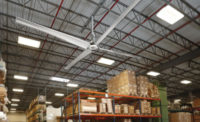While outdoor environments may deal with more extreme temperatures, heavy equipment and frequent movement in industrial workplaces can lead to high, potentially dangerous temperatures in industrial facilities.
Heat stress may be more common than many businesses realize. OSHA reports that millions of American workers encounter heat exposure in the workplace. This exposure leads to thousands of heat-related illnesses a year, in some cases becoming fatal.
Even outside of the workplace, heat accounts for more weather-related fatalities than any other factor, causing 190 deaths in 2021 alone. The National Weather Service also expects this figure to rise. As temperature extremes become increasingly common, industrial organizations must recognize heat-related hazards in their workplaces and take steps to mitigate them.
How to reduce heat stress
While heat stress is a prevalent issue, it’s also preventable. Here are five steps businesses can follow to reduce and mitigate high temperatures in the workplace.
Hydrate
One of the most important factors to address is hydration. OSHA recommends that employees drink at least 8 ounces of water every 20 minutes while working in the heat. Businesses can foster this practice by teaching workers the importance of hydration and letting them bring water bottles into the workplace.
Another helpful step is to set up water coolers or other hydration stations throughout the workplace. Break rooms should have accessible water and sports drinks so employees can hydrate sufficiently during rest periods. Signage about the importance of drinking water can encourage workers to consume more fluids, too.
Ventilate
Industrial facilities should also address their indoor ventilation. Installing efficient HVAC systems is the first step to ensuring proper ventilation. If energy consumption is a concern, workplaces can use smart thermostats and similar internet of things (IoT) technologies to ensure cooling systems provide ideal temperatures with minimal electricity waste.
Some heavy machinery may require its own ventilation system, too. Any machine that gives off excess heat or steam should have local exhaust infrastructure to ensure its radiant heat doesn’t affect nearby workers. Portable fans or AC units can help further mitigate high-heat areas.
Insulate
Another engineering control that reduces heat stress is insulating heat-radiating equipment. Heat shields around machines can prevent hot air from circulating throughout the workplace. However, it’s important that these shields work with proper ventilation instead of as a replacement.
Insulating wraps around pipes and valves can also reduce radiant heat. Implementing these systems will also produce economic benefits. Some valve covers can lead to savings as high as $812.80 a year per pipe by reducing energy loss through heat. These savings can help offset the upfront costs of the additional infrastructure.
Automate
Like with many other workplace hazards, automation can help mitigate heat-related risks. High-heat areas and machinery won’t be as dangerous to workers if employees don’t have to get near them as often. Industrial facilities can enable this by automating the workflows closest to significant heat sources.
Even moderate automation can help. Automating just a few tasks would let employees accomplish the same work in less time, minimizing the time they have to spend near hot equipment or in the sun. While workplaces may not be able to automate every heat-exposed workflow, they can likely at least streamline some.
Monitor
Managers must also monitor temperature hazards and their impact on workers. Thermometers throughout the workplace can reveal if any areas see consistently high temperatures and need additional cooling infrastructure. Similarly, excessive sweat, tiredness, or complaints among workers could suggest that something should change.
Real-time monitoring equipment is even more helpful. Wearable temperature sensors can alert workers and managers when the employee’s body temperature gets too high or they’re in danger of becoming dehydrated. They can then respond as necessary by taking breaks or drinking water to prevent heat illness.
Industrial workplaces must address heat stress
Heat stress can have severe effects on employee health and safety, so it deserves attention. Any industrial workplace should review its workflows and equipment to identify areas where high heat exposure may occur. They can then follow these steps to reduce and mitigate these risks – protecting workers and ensuring higher productivity.
Manufacturing and other heavy industries see more heat-related occupational injuries than they should. Heat stress may be prevalent, but it’s also preventable. Addressing these hazards begins with understanding their impact.



